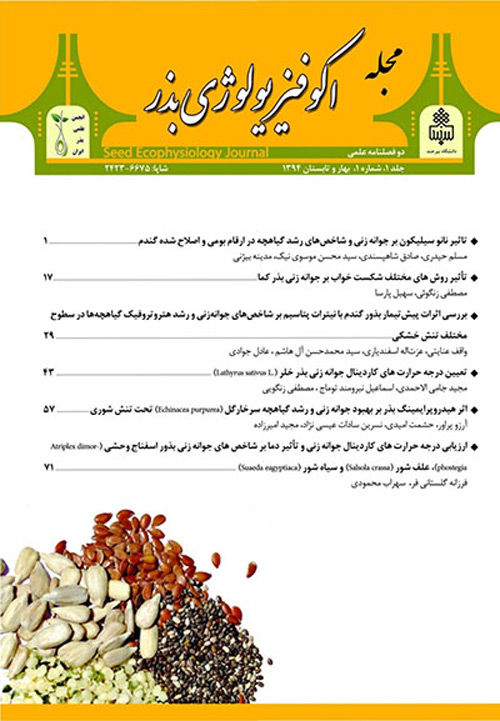The effect of heavy metals on seed germination and seedling growth of radish (Raphanus sativus L.)
Uptake of heavy metals by plants can result in harmful effects to plants and the plants are an important part of the food chain constitute, so a great danger for humans and other members of the food chain can have. Germination is the first stage of the plant life and is one of the most sensitive physiological processes that affected by hormonal and environmental factors (biotic and abiotic stresses). Heavy metals affect the germination of two ways; through general toxicity and inhibiting the absorption of water. Radish is an annual plant with the scientific name Raphanussativus belongs to the Brassicaceae family. The root is edible parts of this plant, which is in direct contact with soil and heavy metals can enter into the roots and stored along with the photosynthetic material. Among the studied plants, radish has ability to absorb and accumulate heavy metals and have been proposed for phytoremediation. However, there is no exhaustive research that showed the impact of the heavy metals Cadmium, Lead, Nickel and Cadmium on the germination and seedling growth of radish. Therefore, this research aimed to investigate the effect of different concentrations of heavy metals Cadmium, Lead, Nickel and Cobalt on germination and seedling growth of radish was conducted.
This experiment was conducted based on completely randomized design with three replications in Research Laboratory, Department of Horticulture Science, Faculty of Agriculture, and University of Birjand in 2015. Treatments included heavy metals Lead, Nickel, Cadmium and Cobalt with concentrations of 0 (control), 50, 100, 200, 400 and 800 mg/l. The measured traits were germination percent, germination rate, mean germination time, seed vigor index, root length, shoot length, root to shoot length ratio and dry weight of root, shoot and total.
The results showed that the effect of heavy metals on seed germination characteristics and seedling growth of radish was significant at the 1% level. The impact of low levels of heavy metals on seed germination (percentage and rate of germination) were not significant, but have the positive effects on growth traits (e.g., length of root and shoot and dry weight of root, shoot and total) and increased them. Among the metals studied the toxicity of Cadmium was higher than the other metals and Cobalt in ranked next after that. Seed germination percent were decreased with concentration of 800 mg/l of Lead, Nickel, Cadmium and Cobalt by 2, 4, 60 and 70 percent as compared to the control, respectively. The lowest and the highest germination rate were obtained from metals Cobalt and Lead with concentrations of 800 and 50 mg per liter, respectively. It is reported that heavy metals physiologically inhibit water uptake by seeds and plants and thereby prevents seed germination. It has been suggested that high concentrations of heavy metals cause damage to the embryo or even death it. Moreover, reduction of germination due to heavy metals could be due to its accumulation in the cell and thus its affinity with proteins which reduced the synthesis and production of structural proteins required for cell division and growth and germination processes. The highest root length (9.64 cm) and shoot length (7.04 cm) were obtained from metals Lead and Nickel with concentrations of 100 and 400 mg per liter, respectively. Metals Lead, Nickel, Cadmium and Cobalt with concentration of 800 mg/l were decreased root dry weight by 42, 28, 88 and 90 percent as compared to the control, respectively. The highest total dry weight (0.10 g) was obtained from Lead at concentration of 100 mg/l. Heavy metals by preventing mitotic divisions and cell elongation reduced growth of root and shoot. The results indicate that germination and seedling growth of radish is possible in areas contaminated by heavy metals.


